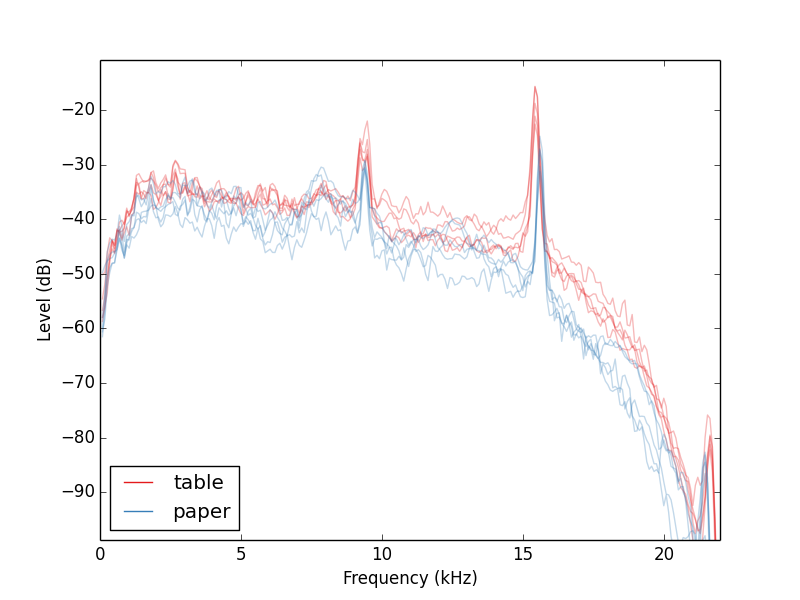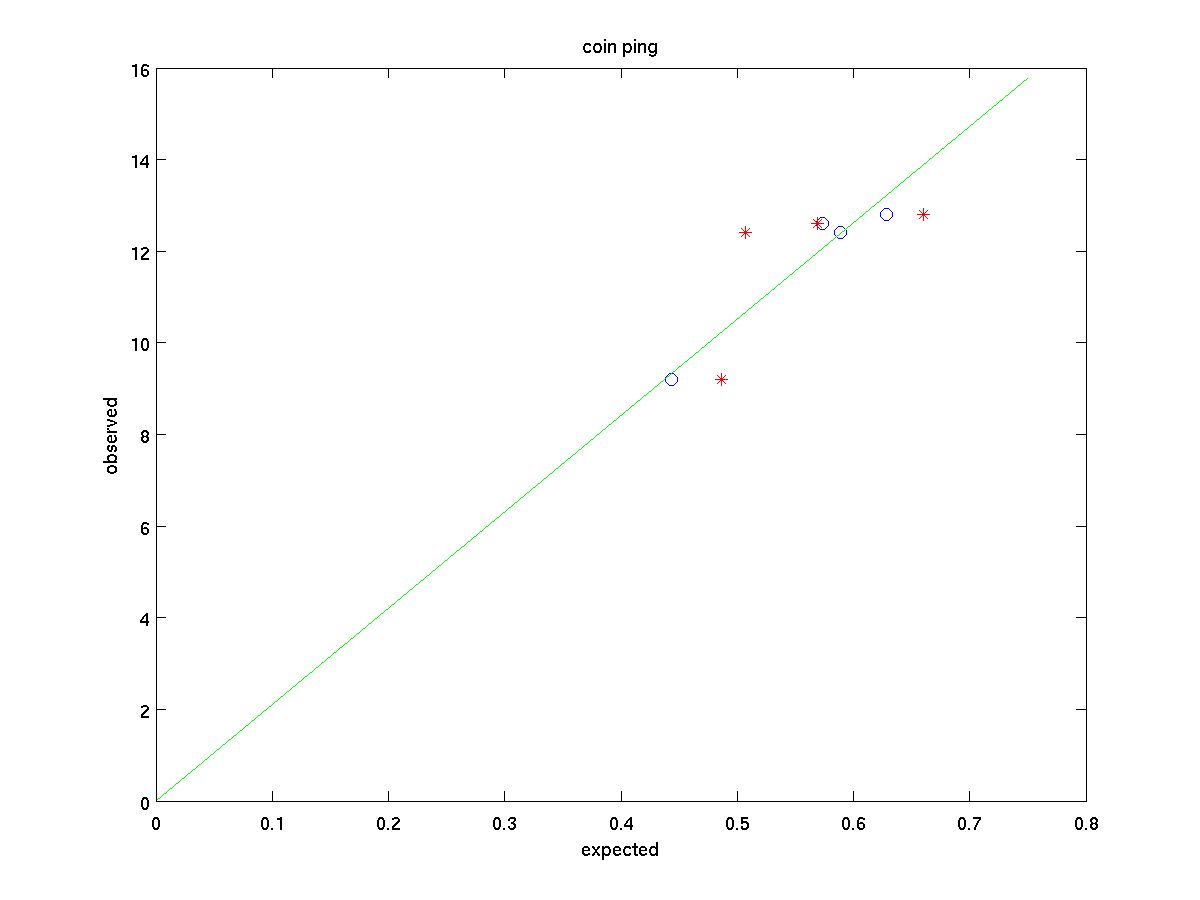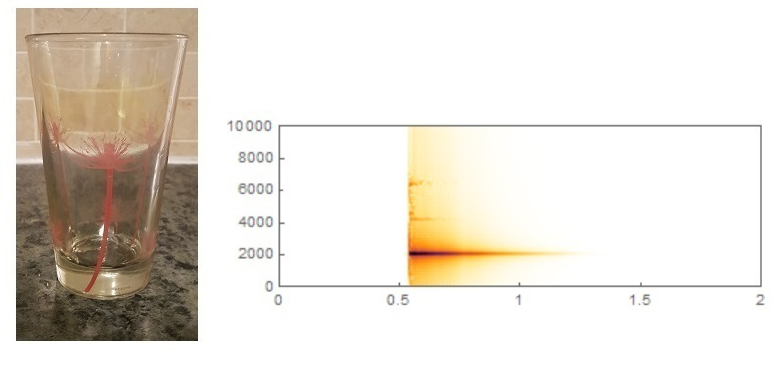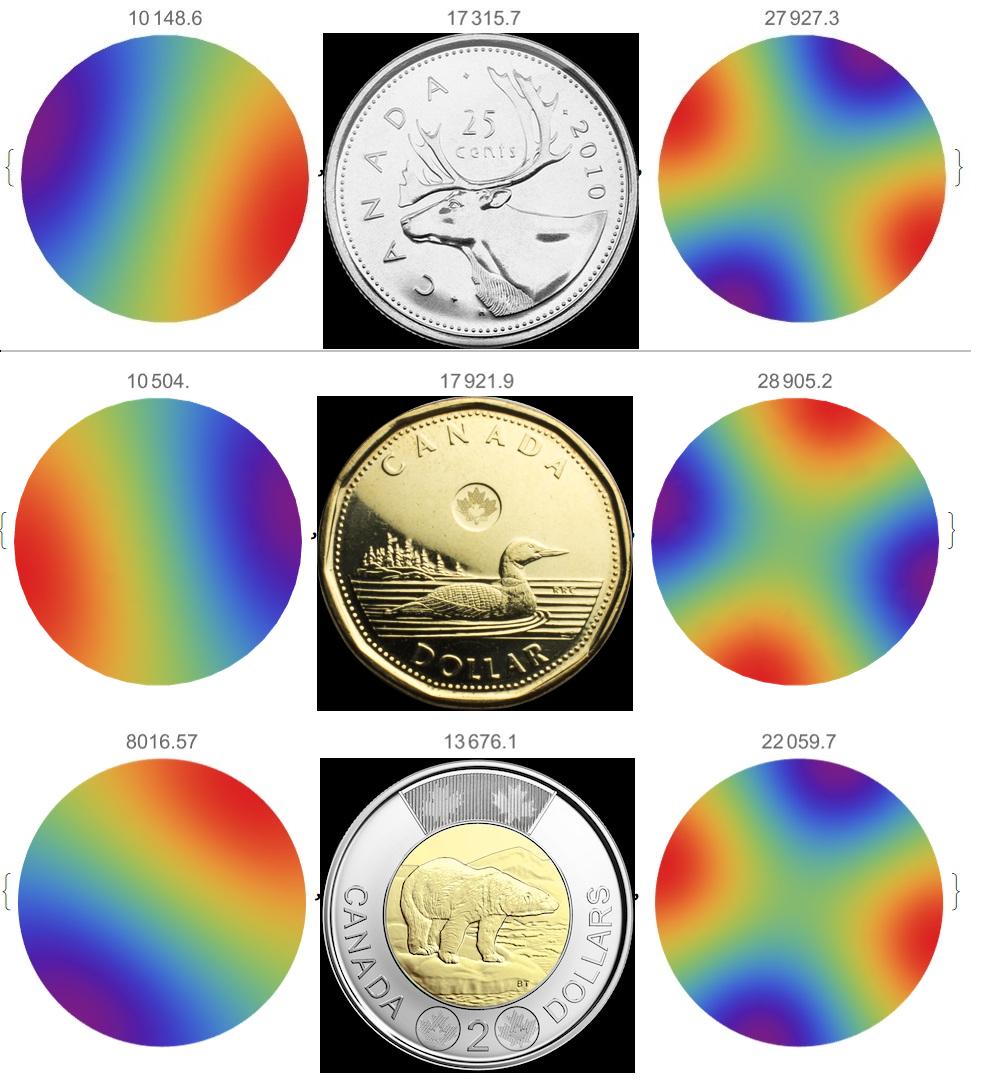The other day, I bumped my bookshelf and a coin fell down. This gave me an idea. Is it possible to compute the mass of a coin, based on the sound emitted when it falls?
I think that there should be a way to do it. But how?
The other day, I bumped my bookshelf and a coin fell down. This gave me an idea. Is it possible to compute the mass of a coin, based on the sound emitted when it falls?
I think that there should be a way to do it. But how?
So, I decided to try it out. I used Audacity to record ~5 seconds of sound that resulted when I dropped a penny, nickel, dime, and quarter onto my table, each 10 times. I then computed the power spectral density of the sound and obtained the following results:

I also recorded 5 seconds of me not dropping a coin 10 times to get a background measurement. In the plot, I've plotted all 50 traces on top of one another with each line being semi-transparent.
There are several features worth noticing. First, there are some very distinct peaks, namely the 16 kHz and 9 kHz quarter spikes, as well as the 14 kHz nickel spike. But, it doesn't appear as though the frequencies follow any simple relationship like the $ \propto m^{-1/3}$ scaling the order of magnitude result Floris suggests.
But, I had another idea. For the most part, we could make the gross assumption that the total energy radiated away as sound would be a fixed fraction of the total energy of the collision. The precise details of the fraction radiated as sound would surely depend on a lot of variables outside our control in detail, but for the most part, for a set of standard coins (which are all various, similar, metals), and a given table, I would expect this fraction to be fairly constant.
Since the energy of a coin, if it's falling from a fixed height, is proportional to its mass, I would expect the sound energy to be proportional to its mass as well. So, this is what I did. I integrated the power spectral densities and fit them into a linear relationship with respect to the mass. I obtained:

I did a Bayesian fit to get an estimate of the errors. On the left, I'm plotting the joint posterior probability distribution for the $\alpha$ intercept parameter and the $\beta$ slope parameter, and on the right, I'm plotting the best fit line, as well as $2\sigma$ contours around it to either side. For my priors, I took Jeffrey's priors.
The model seems to do fairly well, so assuming you knew the height that coins were dropping and had already calibrated to the particular table and noise conditions in the room under consideration, it would appear as though, from a recording of the sound the coin made as it fell, you could expect to estimate the mass of the coin to within about a 2-gram window.
For specificity, I used the following coins:
Edit: Scaling Collapse
Following Floris, we can check to see how accurate the model $ f \sim E^{1/2} m^{-1/3} \eta^{-1} $ is. We will use the data provided, and plot our observed power density versus a scaled frequency $f m^{1/3} \eta E^{-1/2}$. We obtain:

which looks pretty good. In order to see a little better how well they overlap, I will reproduce the plot but introduce an offset between each of the coins:

It is pretty impressive how well the spectra line up. As for the secondary peaks for the quarter and nickel, see Floris' afterthought.
Someone in the comments asked what happens if we change the thing the coins fall onto. So, I did some drops where instead of falling onto the table directly, I had the coins fall onto a piece of paper on the table. If you ask me, these two cases sounded very different, but their spectra are very similar. This was for the quarter. You'll notice that the paper traces are noticeably below the table ones.

The actual composition of the coin seems to have a fairly large effect. Next, I tried three different pennies, each dropped 5 times. A 1970s brass penny, A 2013 zinc penny and a 1956 bronze penny.

Hoping to better resolve the second harmonic, I tried some other larger coins:

Notice that the presidential dollar has a nicely resolved second harmonic. Notice also that the Susan B dollars not only look and feel like quarters, they sound like them too.
Lastly, I worried about just how repeatable this all was. Could you actually hope to measure some of these spectra and then given any sound of a coin falling determine which coins were present, or perhaps as in spectroscopy tell the ratios of coins present in the fall. The last thing I tried was to drop 10 pennies at once, and 10 nickels at once to see how well resolved the spectra were.

While it is fair to say that we can still nicely resolve the penny peak, it seems nickels in the real world have a lot of variations. For more on nickels, see Floris' second answer.
scipy.signal.welch or a basic scipy.signal.periodogram
$\endgroup$
If you have the dimensions and material of an object, you can compute both the mass and the normal vibration modes. Just the mass is not enough - a large paper "coin" will have a different fundamental frequency than a small tungsten sphere.
A summary of everything that comes below - the result of several edits, and including a nice interaction with the other answer from Alemi:
The relationship between the fundamental frequency of the "ping" of a coin and its mass is given (approximately) by
$$m \propto \frac{t\sqrt{E}}{f^{1/3}D}$$ where
$E$ = Young's modulus
$t$ = thickness
$m$ = mass of coin
$D$ = diameter of coin
$f$ = fundamental frequency
Here are the details of how I got there...
If you assume that all "coins" are of the same aspect ratio (ratio of diameter to thickness) and made of the same material, then it is indeed possible to compute the relationship between fundamental frequency and mass. From dimensional analysis, if we assume that frequency is a function of
Then the combination of the above that gives us units of $1/s$ is $$f = \text{const} \cdot \frac{1}{D} \sqrt{\frac{E}{\rho}}$$
Combining this with the mass of the object which is proportional with $\rho D^3$, then assuming $\rho$ is constant (so we can take it out of the equation) we get
$$f = \text{const} \cdot m^{-1/3}E^{1/2}\\ m = \text{const} \cdot E^{3/2}f^{-3}$$
In other words - mass decreases with the third power of the frequency for coins with the same material and aspect ratio.
But that is not how US coins work. From the US mint website, I extracted the following:
$$\begin{array}{|c|cl|cl|cl|cl|cl|} \hline \text{Coin} & \text{Mass} & & \text{Diameter} & & \text{Thickness} & & \text{Material} && \text{Aspect ratio} \\ \hline \text{Penny} & \quad 2.500 && 19.05 && 1.52 && \text{Zn*} && 12.53 \\ \hline \text{Nickel} & \quad 5.000 && 21.21 && 1.95 && \text{Cu-Ni} && 10.88 \\ \hline \text{Dime} & \quad 2.268 && 17.91 && 1.35 && \text{Cu-Ni} &&13.27 \\ \hline \text{Quarter} & \quad 5.670 && 24.26 && 1.75 && \text{Cu-Ni} &&13.86 \\ \hline \text{Old 1c.} & \quad 3.11 && 19.05 && 1.52 && \text{Bronze} && 12.53 \\ \hline \text{* copper plated...} \\ \hline \end{array}$$
So the material isn't always the same, and neither is the aspect ratio. That's going to make it a little bit hard to prove or disprove the relationship.
Still - let's have a shot at it. From the experimental data (@alemi's answer) I read the fundamental frequencies as follows:
$$\begin{array}{|c|cl|} \hline \text{Penny} & 12.6\\ \hline \text{Nickel} & 12.4\\ \hline \text{Dime} & 12.8 \\ \hline \text{Quarter} & 9.2 \\ \hline \end{array}$$
Now the interesting two are the quarter and the dime since they have the same material and the most similar aspect ratio (13.3 vs 13.9, so only a 5% difference). From the ratio of their masses (2.500), we would expect the ratio of frequencies to be 0.74 ($2.5^{-1/3}$). And the observed ratio is 0.72. That is really quite close...
Put another way - if you knew the frequencies for the dime and the quarter, and you had to estimate the mass of the quarter from the dime, you would obtain
$$\begin{align}\\ m &= 2.268 * \left(\frac{12.8}{9.2}\right)^3\\ &= 6.11\end{align}$$
which is an error of about 7% or less than 0.5 g. I think that is spectacular given there is a factor 2.5 difference between the dime and the quarter.
Encouraged by this result, I decided to see if I could get agreement for the four coins given their different aspect ratio and material. Since both bronze and Cu-Ni alloys have a wide range of Young's modulus, I had to guess a bit (all values in GPa):
$$\begin{array}{|c|cl|cl|} \hline \text{material} & \text{Range (GPa)} & & \text{Value (GPa)}\\ \hline \text{bronze} & \quad 96-120 && 110 \\ \text{Cu-Ni} & \quad 120-156 && 120 \\ \hline \end{array}$$
Next, I had to deal with the aspect ratio. After thinking about this, it was plausible that a larger aspect ratio (thinner coin) would have a lower frequency, so I decided to see what happened if I made frequency dependent on $1/\eta$. This led to the following "expected frequency" formula:
$$\text{expected} = \frac{\sqrt{E}}{m^{1/3}\eta}$$
Computing this with the new mass for the penny (3.11 g) I obtained the following plot for the relationship for each of the coins:

In this plot, the red stars are the numbers (scaled to fit the same chart) that would have been obtained without taking account of the aspect ratio; the blue circles correspond to the values with the $1/\eta$ relationship taken into account. Clearly, this improved the fit. Pretty convincing, given the relatively noisy data...
AFTERTHOUGHT
There are multiple frequencies visible in the sound recordings that @alemi showed. Some of these are easily explained by looking at the multiple modes of a simple circular plate - see for example Waller, 1938 Proc. Phys. Soc. 50 70.
Two images from that publication: first, the vibration modes:

And next, their relative frequencies:

This shows that the first harmonic is 1.7x higher than the fundamental frequency. Looking at the data, we see that is indeed about right: in fact, for the quarter we are even seeing the second harmonic (at 2.3x of the fundamental).
The question of the splitting of the fundamental frequency is a bit trickier. If you have ever played with an empty coffee mug, you may have noticed that when you tap the rim, the pitch changes depending on whether you tap right across from the handle, or at 45-degree offset from there. This is because there are two symmetrical modes - one where the handle is a node, and one where it is an antinode. The latter has a slightly lower frequency.
A similar thing may happen with the nickel: when you look at the image of a pre-2005 Nickel, you will see that there is more material in the north-south and east-west direction. This means that there are two vibration modes: the one with nodes in blue, and the one with nodes in red:

Obviously, when the blue lines are the nodes the frequency will be slightly higher.
LITERATURE
I found a paper where this is discussed in some more detail - broadly it agrees with everything said above, and even came up with very similar values for the frequencies (measured and modeled). You can read it at http://me363.byu.edu/sites/me363.byu.edu/files/Emerson_Steed_CoinIdentification.pdf
Interestingly, the authors were unable to capture the sound of the penny, although their model suggested a frequency close to the one that @alemi measured (13.1 kHz). They showed the first vibration mode as

which is a nice colorful 3D representation of the mode described by the 1938 Waller paper.
This is not an advertisement.
Under the rubric of "do try this at home", I wanted to share one more thing that I discovered after writing my previous answer - but it is so unrelated to that answer that I thought it better to write this as a separate post.
I discovered two interesting things. First, when you spin a coin on a hard surface, it "rings" with the characteristic frequencies that @alemi observed during a drop. Second, for three dollars you can get an app on your iPhone that beautifully visualizes this. I don't normally plug a product (my only relationship with the maker of the app is that I bought it…), but here I go… The app is called "SignalSpy"; it's only been on the App Store for a few days, and it didn't have any reviews yet. It has four different modes: oscilloscope, spectrum, levels, and spectrogram. Although all four modes are interesting, I found the spectrogram worked best for these experiments. Here is an example of a screenshot I took when I spun four different gold coins (the Dutch 10 guilder coin - same coin, but different years):

In this plot, the time axis is moving to the left - so new spectra appear on the right, and the oldest spectra "roll-off" on the left. You can see that I spun a few different coins - the last four bands are the four different coins spun one after the other. Most things are quite repeatable: the fundamental frequency is a bright band around 8.2 kHz, there is a faint band at 11, then a cluster of bands around 17.5 - 19 kHz.
To make this experiment work properly, I placed the phone on a granite countertop in a quiet room. I spun the coins about 6 inches from the bottom edge of the phone (where the microphone is on the iPhone 5) - any closer and the "rumble" of the coin rolling on the surface dominates the spectrum. At this distance, I was getting nicely resolved modal frequencies.
I repeated this experiment with 31 different types of coins - the advantage of doing a lot of traveling. Some coins are amazingly consistent - the 10 yen, the Canadian 2 dollar, the half Shekel, … - while others are quite variable. The one that really stood out was the US nickel. In particular, the "mode splitting" that was observed earlier is quite puzzling. On some nickels, it doesn't show up at all; on others, it is very significant. This suggests that my earlier explanation (modes relating to the relief on the coin) can't be the whole story. And yes, I did check that the orientation of the face and the building (Monticello) is consistent across all the coins.
I have tried to measure whether there was a difference in roundness (an elliptical shape would cause mode splitting), or in planarity (if the coin is not flat you would expect mode splitting). Within the accuracy of my digital caliper (nominally 0.01 mm), I could see no obvious effect that I could trace to either of these, but I'm going to try to repeat this experiment when I have access to more accurate measurement equipment - both to measure dimensions and weights. That might be a while though.
Let me show you what the spectra of a collection of nickels (sorted approximately by a degree of splitting) look like:

I did not spin all 20 coins in quick succession - in fact, this is a composite of several screenshots I took on my phone, and I added the larger scale on the left to help measure the peak positions.
I discovered an interesting factoid about the nickel - by law, its weight is allowed to vary quite a bit - with a nominal mass of 5.000 grams, it has an allowed tolerance of 0.194 gram (see http://www.law.cornell.edu/uscode/text/31/5113). I have not had the chance to get the detailed specifications of all the coins I measured - when I do, I will evaluate my formula above and see whether the formula I had derived earlier holds over a wide range of sizes and materials. I am hoping that the aspect ratios will be sufficiently different that I can explore whether the "linear in $\eta$" assumption is true or not.
I am sharing this in the hope that others will start experimenting - this is a really easy and cool experiment to do. The app works on the iPad as well.
I don't mean to take anything away from the previous great answers, but the "simple and to the point" answer is, a very qualified, yes.
By qualified, I mean one must know the coin's composition, thickness, diameter(or shape), density distribution, country of manufacture, etc. If we make assumptions and restrictions, then it becomes possible to calculate the mass of the coin (to some degree of accuracy), from its "ping" frequency. The formula to use, is the one provided by Floris.
I think that the main question is somehow connected with energy equation $E=m c^2=\hbar \nu$. In turn my answer is connected with the question 3D Elastic waves in a glass. My first impression was that coin exabits some elastic deformation after collision and that this deformation can be analyzed with using eigenfunctions. Really, several tested cups and glasses are shown spectrogram with highest picks related to eigenmodes as demonstrated in Figure 1.

But coins actually not follow this rule. Sound from impact of coin with some wooden, metallic or stone object has very low frequency compared to the main mode as it shown in @alemi answer. Also we can use sound tracks to distinguish coins, it is not so precise as in a case of cups or glasses. Nevertheless we could discus some detector of coins to make sound more related to individual coin. As detector we may use, for example, metallic box like a tin. As we put coin in a can and shake, then it produces very specific sound for every coin. For example, I have tested 3 Canadian coins - quarter, 1 dollar of 2018 and 2 dollars of 2005 in an empty tin from Akbar Ceylon tea. There are 3 very different sound tracks shown in Figure 2
Therefore we may conclude that every coin produces specific sound but it is not related to the mass only. In Figure 3 shown equipment I have used for my experiment - empty tin, computer and coins.
 Note, that Canadian coins 1 dollar and 2 dollars have very special design - see Figure 3. Nevertheless I try to compute eigenvalues using my code published here - see Figure 4. The first 3 modes for quarter and loonie are very close (values in Hz are shown over figures) while masses are differ - 4.4 g and 6.27 g respectively. It is why we can't use sound from impact only to distinguish them. On the other hand they have different sound in a can - see Figure 2.
Note, that Canadian coins 1 dollar and 2 dollars have very special design - see Figure 3. Nevertheless I try to compute eigenvalues using my code published here - see Figure 4. The first 3 modes for quarter and loonie are very close (values in Hz are shown over figures) while masses are differ - 4.4 g and 6.27 g respectively. It is why we can't use sound from impact only to distinguish them. On the other hand they have different sound in a can - see Figure 2.

Coins of different composition and shape will give different sounds . Lets consider simillar shape and compostion of coin, and changing only its mass. Also it falls from same height and on same surface. Let the coin is metalic (iron).
When it falls on surface it will produce noise. By law of conservation of energy, heavier the coin more the potential energy will be converted in kinetic energy and more will hence be sound by striking down.
Hence you just need to measure its amplitude in decible to know its sound.
PS: You can also use duration of sound, as they will also vibrate and produce sound for different time intervals
PS2: Changing composition of coin will produce different frequencies, which can again be easily measured and then callibrated by amplitude.
The answer to this is yes . If the coin dropped on a drum it would sound a note whose amplitude would be proportional to its mass since force on stretched drum surface would be proportional to mass.The drum obeys Hooke's law force is proportional to extension. Get a decibel meter!
Basically, the answer is yes if sound generation is the only thing that's causing energy loss when a coin drops from a height and smacks into something massive like the ground. How? Well, in this scenario, all the energy loss happens as sound. In this ideal inelastic collision scenario, where there's only sound as the energy loss (no friction, no heat, no squishing), the sound energy made is equal to the kinetic energy the coin had just before it hit the ground. If you drop the coin straight down without spinning it and giving it a push, its kinetic energy is just from its fall, which equals its initial gravitational potential energy ($m.g.h$). Here, $m$ is the coin's mass, $g$ is gravity, and $h$ is the height. Now, we find $m$ via $mgh = S$, where $S$ is the total sound energy released.
But what if the coin starts spinning when you drop it (if you accidentally give it some rotational energy)? In that case, the equation becomes $mgh + R(m, d) = S$, where $R$ is the initial rotational kinetic energy given to the coin, depending on its mass ($m$) and diameter ($d$) via the inertia moment $I$ of the coin. If you also give it a little shove initially (giving it some speed), then the equation becomes $mgh + T(m) + R(m,d) = S$, where $T(m)$ is the initial translational kinetic energy given to the coin.
So, theoretically, you could figure out the mass of the coin just by measuring the total sound energy released and using the above equations. But in reality, it's almost impossible to track $T(m)$ and $R(m,d)$ in every situation as they are also material dependent, so the practical answer is probably NO. Hope this helps!